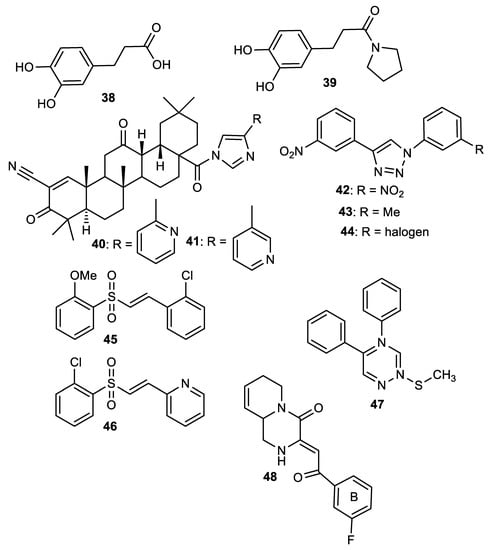Several nitrogen heterocyclic analogues have been applied to clinical practice, and about 75% of drugs approved by the FDA contain at least a heterocyclic moiety. Thus, nitrogen heterocycles are beneficial scaffolds that occupy a central position in the development of new drugs. The fact that certain nitrogen heterocyclic compounds significantly activate the NRF2/ARE signaling pathway and upregulate the expression of NRF2-dependent genes, especially HO-1 and NQO1, underscores the need to study the roles and pharmacological effects of N-based heterocyclic moieties in NRF2 activation. Furthermore, nitrogen heterocycles exhibit significant antioxidant and anti-inflammatory activities. NRF2-activating molecules have been of tremendous research interest due to their therapeutic roles in neuroinflammation and oxidative stress-mediated diseases.
- nitrogen heterocycles
- antioxidant
- anti-inflammatory
- neurodegenerative diseases
- NRF2
1. Introduction
2. Nitrogen Heterocycles as Modulators of the NRF2 Pathway
The tendency of the nitrogen atom to readily form hydrogen bonding and various weak interactions with biological targets has distinguished N-based heterocyclic scaffolds as building blocks for a couple of drug candidates and expanded their utility in several therapeutic applications. The nitrogen atom of nitrogen heterocycle has a lone pair of electrons, which act as a hydrogen bond acceptor, resulting in the formation of a hydrogen bond (hydrogen atom bonded to an electronegative atom) network which enhances the stability of the nitrogen heterocycle and its interactions with diverse biological molecules [15][16][17][25,26,27]. Thus, both saturated and unsaturated N-based heterocycles are bioactive molecules of utmost medicinal importance.2.1. Five-Membered Nitrogen Heterocycles and NRF2 Activation
Five-membered heterocyclic rings are commonly found in pharmaceuticals. It can be stipulated that their chemical structures permit variable interactions with essential biomolecules, hence their predominance in pharmaceuticals. Five membered nitrogen heterocycles such as pyrrole, imidazoles, pyrazoles and many more are components of the best-selling heterocyclic pharmaceuticals [18][31]. Currently, the pyrrole derivative, 3-carboxylic acid pyrroles have been patented as active NRF2 regulators (US2020/0031820A1).2.1.1. Pyrrolidine/Pyrroline Analogues
Recent synthetic methods for pyrrolidines have been reviewed by [19][35]. A pyrrolidine derivative known as pyrrolidine dithiocarbamate (1) (Table 1) has been reported as a potent inducer of the NRF2 signaling pathway [20][36]. Pyrroline derivative (2) (Table 1) exerts protection against oxidative stress and hyperphosphorylation in neurodegenerative diseases via the activation of the NRF2–ARE pathway and upregulation of the expression of protein levels of HO-1 and NQO1 [21][41].2.1.2. Pyrazoles
Pyrazoles are commonly prepared by reacting α,β-unsaturated aldehydes with hydrazine followed by dehydrogenation [22][45]. Several pyrazole analogues, such as arylcydohexyl pyrazoles (W02017060855A1), n-aryl pyrazoles (W02018109642) and biaryl pyrazoles (W02017060854) are already established NRF2 regulators. The antioxidant effect of pyrazoles has been linked to the activation of the NRF2/KEAP1 signaling pathway. Thus, pyrazole (3) (Table 1) induces oxidative damage in NRF2 knockout mice but not in wild-type mice due to compensative enhancement of NRF2-regulated antioxidant capacity. Furthermore, pyrazole derivative (4) (Table 1) induces the NRF2 signaling pathway and inhibits glycogen synthase kinase-3β (GSK3β) [23][51]. The ability of compound 4 to activate NRF2 is ascribed to the presence of 2,4-dihydropyrano [2,3-c]pyrazole core, which also acts as a GSK3β inhibitor. Interestingly, the introduction of a pyrazole moiety to the curcumin scaffold improves the NRF2 activity and antioxidant capacity of curcumin. Evidently, the curcumin pyrazole derivative (5) (Table 1) has been found to exhibit better neuroprotective effects than curcumin and edaravone due to the pyrazole moiety [24][52].2.1.3. Imidazolidine/Imidazole Analogues
The authors of [25][59] reported that a compound containing imidazolide, a conjugate base of IH-imidazole–CCDO-imidazolide (6) (Table 1) is 100 times more potent than DMF, a known NRF2 activator, in the activation of the NRF2 signaling pathway. Compound 6 is a synthetic oleanane triterpenoid containing an imidazole ring. It inhibits the production of nitric oxide and attenuates ROS generation in RAW264.7 cells; it also induces about 52 NRF2-target genes, including NQO1, and HO-1 via NRF2 activation. This type of NRF2 activation has also been linked to the amelioration of cardiac dysfunction and emphysema induced by cigarette smoke [26][62]. Furthermore, an imidazole analogue olmesartan (7) (Table 1) has been of therapeutic importance in hypertension.2.1.4. Triazoles
Triazoles possess significant anti-inflammatory and antioxidant activities, and thus they have been extensively studied in neurodegenerative diseases [27][28][68,69]. The triazole derivatives (8 and 9) (Table 1) bearing 1,4-diaryl-1,2,3-triazole scaffolds significantly activate the NRF2 signaling pathway by inhibiting the KEAP1/NRF2 protein–protein interaction [29][70]. They also upregulate the expression levels of NRF2 dependent genes, including HO-1 and NQO1. 1,2,4-Triazole derivative (10) (Table 1) exerts a therapeutic effect in cerebral ischemic injury. It eliminates ROS, restores mitochondrial transmembrane potential, and attenuates neurological deficits in middle cerebral artery occlusion in acute ischemic stroke via NRF2 activation and induction of its antioxidant proteins such as HO-1, NQO1 and GCLC [30][71]. In a similar report, [31][72] reiterated that the neuroprotective effect of 1,2,4-triazole derivative (11) (Table 1) in cerebral ischemic injury is initiated by the antioxidant response element (ARE) and antioxidant genes HO-1 and NQO1 via the activation of the NRF2–ARE signaling pathway. Another 1,2,4-triazole analogue (12) (Table 1) with good bioavailability reportedly exhibited significant neuroprotective action against ischemic brain injury [32][73].2.2. Six-Membered N-Heterocyclic Rings and NRF2 Activation
2.2.1. Piperidines
Piperidine exhibits antioxidant and anti-inflammatory activities and has been utilized as an essential scaffold in drug discovery [33][79]. A piperidine alkaloid (piperine) (13) (Table 1) protects neuronal cells against H2O2-induced ROS accumulation, apoptosis and oxidative damage via NRF2-dependent phase II antioxidant enzymes, especially HO-1 and NQO1 [34][76]. The authors of [35][80] reported that the cinnamyl piperidine analogue (14) (Table 1) inhibits neddylation, migration and increases apoptosis of gastric cancer cells via a process partly mediated by the NRF2–KEAP1 signaling pathway.2.2.2. Pyridine Analogues
Pyridines possess antioxidant and anti-inflammatory properties [36][37][85,86]. Pyridine alkaloid (15) (Table 1) obtained from Fusarium lateritium enhances the expression of NRF2 and its target genes HO-1, and NQO1, thereby attenuating oxidative stress and apoptosis in glutamate-treated hippocampal HT22 cells [38][87]. This implies that the significant neuroprotective effects of pyridine can be attributed to its ability to activate the NRF2 signaling pathway. Pyridine derivative (16) (Table 1) also protects dopaminergic neurons from MPTP-induced oxidative stress; it suppresses the generation of proinflammatory enzymes and cytokines via the activation of NRF2 and upregulation of the mRNA levels of HO-1, SOD1, GCLM and GCLC, the NRF2-dependent antioxidant enzymes [39][88].2.2.3. Pyrimidine and Pyrazine Analogues
A pyrimidine analogue 17 (Table 1) has been found to elevate the mRNA and protein levels of NRF2-target antioxidant enzymes such as HO-1, NQO1, GCLM and GCLC in BV-2 cells. Through NRF2 activation, it exerts anti-inflammatory, antioxidant and neuroprotective effects. In addition to the upregulation of HO-1 via the activation of NRF2/HO-1 signaling, compound 17 also activates AMPK/HO-1 signaling and through these processes, it effects neuroprotection of nigral neurons in Parkinson’s disease [40][94]. In a similar development, Lee and co-workers [41][95] further corroborated that pyrazolo[3,4-d]pyrimidine (18) (Table 1) protects nigral dopaminergic neurons and inhibits the dopamine deficiency-related motor deficits via NRF2 activation and upregulation of HO-1, NQO1, GCLM and GCLC. Another Pyrazolo[3,4-d]pyrimidine derivative (19) (Table 1) ameliorates hepatic ischemia reperfusion injury in mice by inhibiting p21-activated kinase 4 (PAK4) due to its ability to stabilize NRF2 and enhance antioxidant capacity in mice [42][96]. Pyrazine which belongs to the same diazine class as pyrimidine has two nitrogen atoms in the 1- and 4-positions of the ring. Tetramethyl pyrazine (20) (Table 1) exhibits a significant antioxidant and anti-apoptotic activity in MPTP-induced Parkinson’s disease in mice via the upregulation of the expression levels of NRF2, GCLC, Bax and Bcl-2 [43][97].2.2.4. Triazines
Triazines exhibit antioxidant and anti-inflammatory activities [44][45][101,102]. Triazines also exert neuroprotective effects in neurodegenerative diseases. Triazine analogues (21 and 22) (Table 1) maintain redox homeostasis, improve cell survival and enhance the overall antioxidant responses in organisms via the activation of NRF2 and upregulation of GPx1, GCS, SOD and CAT in neuronal cells [46][103]. Similarly, 1,2,4-triazine (23) (Table 1) inhibits H2O2-induced cell death, and exerts a neuroprotective effect in neuron-like PC12 cells via the activation of NRF2 and induction of GCS, HO-1 and GPX [47][104].| S/N | Molecule/Structure | Effective concentration(s) | NRF2 Target Genes |
|---|
| S/N | Molecule/Structure | Effective Concentration(s) | NRF2 Target Genes | Disease of Interest | Study Model | Biological Activity of Interest | Reference(s) | ||||||
|---|---|---|---|---|---|---|---|---|---|---|---|---|---|
| 24 | Indole core | 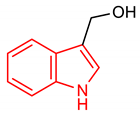 | (1H-indol-3-yl)methanol |
20mg/kg | NQO1 | Prostate cancer | Mice | Antioxidant | [58] | [114] | |||
| 25 | 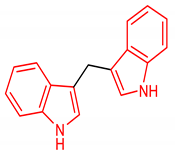 | 3,3′-diindolylmethane |
25–100 µM | NQO1, HO-1 | Oxidative stress | NIH3T3 Cells | Antioxidant | [59] | [115] | ||||
| 5 µM | NQO1 | Prostate cancer | TRAMP mice, C1 Cells |
Antioxidant, Anticancer | [65] | [116] | |||||||
| 26 |  | (3R,6S,12aR,13aR)-3-isopropyl-12a-methoxy-13a-methyl-6-(2-methylprop-1-en-1-yl)-2,3,13,13a-tetrahydro-1H-pyrazino[1’,2’:3,4]pyrimido[1,6-a]indole-1,4,12(6H,12aH)-trione |
10–50 µM | NQO1 | Oxidative stress | SH-SY5Y Cells | Antioxidant | [60] | [117] | ||||
| 27 | 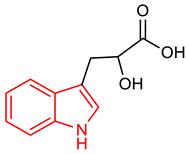 | 2-hydroxy-3-(1H-indol-3-yl)propanoic acid |
0.1–10 mM | NQO1, SOD-2, GPX-2 | Intestinal inflammation | Gut epithelial cells | Antioxidant, Anti-inflammatory | [61] | [118] | ||||
| 28 | 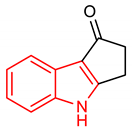 | 2,3-dihydrocyclopenta[b]indol-1(4H)-one |
0.1 µM | NQO1 | PD | SH-SY5Y | Antioxidant | [62] | [119] | ||||
| 29 |  | 1-((4-methoxyphenyl)sulfonyl)-5-(((4-methoxyphenyl)sulfonyl)methyl)-2-methyl-N’-phenyl-1H-benzo[g]indole-3-carbohydrazide |
4–100 µM | NQO1 | Oxidative stress | MEF Cells, HepG2 Cells | Antioxidant | [63] | [120] | ||||
| 30 | 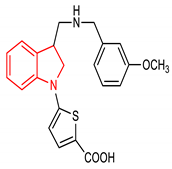 | 5-(3-(((3-methoxybenzyl)amino)methyl)indolin-1-yl)thiophene-2-carboxylic acid |
5 µM | NQO1 | Oxidative stress | HeLa Cells | Antioxidant | [64] | [121] | ||||
| 31 | Quinazoline core | 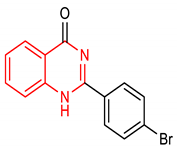 | 2-(4-bromophenyl)quinazolin-4(1H)-one |
15, 30 mg/kg | NQO1, HO-1 | Liver carcinogenesis | Rat | Antioxidant, Anticancer | [66] | [131] | |||
| 32 |  | indolo[2,1-b]quinazoline-6,12-dione |
1 µM | HO-1, GCLC | Oxidative stress | HepG2 Cells | Antioxidant | [67] | [132] | ||||
| 33 | Isoquinoline core |  | (Z)-3-(2-(3-fluorophenyl)-2-oxoethylidene)-2,3,6,7-tetrahydro-1H-pyrazino[2,1-a]isoquinolin-4(11bH)-one |
10 µM | NQO1 | Oxidative stress | HepG2-ARE-C8 Cells | Antioxidant | [68] | [141] | |||
| 34 | 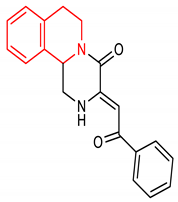 | (Z)-3-(2-oxo-2-phenylethylidene)-2,3,6,7-tetrahydro-1H-pyrazino[2,1-a]isoquinolin-4(11bH)-one |
10 µM | NQO1 | Oxidative stress | HepG2-ARE-C8 Cells | Antioxidant | [68] | [141] | ||||
| 35 |  | 7-fluoro-1,3-diphenylisoquinolin-1-amine |
10, 25 mg/kg | HO-1 | Amnesia, Oxidative stress | Mice | Anti-amnesic, Antioxidant | [69] | [142] | ||||
| 36 | 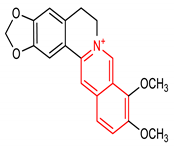 9,10-dimethoxy-5,6-dihydro-[1][70]dioxolo[4,5-g]isoquinolino[3,2-a]isoquinolin-7-ium | 9,10-dimethoxy-5,6-dihydro-[1,3]dioxolo[4,5-g]isoquinolino[3,2-a]isoquinolin-7-ium |
50 mg/kg | NQO1, HO-1, SOD-1, CAT, GPx | Gouty arthritis | Rats | Antioxidant, anti-inflammatory | [71] | [143] | ||||
| 37 | 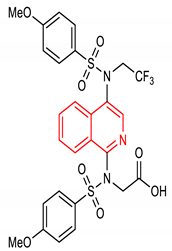 | 2-(4-methoxy-N-(4-(4-methoxy-N-(2,2,2-trifluoroethyl)phenylsulfonamido)isoquinolin-1-yl)phenylsulfonamido)acetic acid |
15 µM | NQO1 | Hepatic injury | U2OS Cells | Antioxidant, Hepatocellular protection | [72] | [144 | [73] | ,145] | ||
| Disease of Interest | Study Model | Biological Activity of Interest | Reference(s) | ||||||||||
| 1 | Pyrrolidine core |  | Pyrrolidine-1-carbodithioic acid |
20 mg/kg | HO-1, NQO1, GCLM, GCLC | AD, Oxidative stress | Mice, Astrocytes | Antioxidant | [20] | [36] | |||
| 100 mg/kg | Infertility | Rats | Antioxidant, Anti-inflammatory | [48] | [37] | ||||||||
| 50 mg/kg | GPx1, GPx4 | Inflammation bowel disease (IBD) | Mice | Antioxidant, Anti-inflammatory | [49] | [38] | |||||||
| 100 µM | NQO1, GCLM | Oxidative stress | HepG2 Cells | GCL induction, NRF2 localization | [50] | [39] | |||||||
| 1–10 µM | HO-1, NQO1, GCLM, GCLC | AD, Aβ toxicity | Mice | Antioxidant, neurogenesis | [51] | [40] | |||||||
| 2 | Pyrroline core |  | ( | Z | )-Methyl-4-(3,4-dihydroxybenzylidene)-2-methyl-5-oxo-1-phenethyl-4,5-dihydro-1H-pyrrolin-3-carboxylate. | 1 µM | HO-1, NQO1 | Neurodegenerative diseases | SH-SY5Y Cells | Antioxidant | [21] | [41] | |
| 3 | Pyrazole core |  | 1 | H | -Pyrazole | 150 mg/kg | HO-1, GST | Liver injury, Oxidative stress | Mice | Antioxidant | [52] | [49] | |
| 150 mg/kg | HO-1 | Oxidative stress | Mice | Antioxidant | [53] | [50] | |||||||
| 4 | 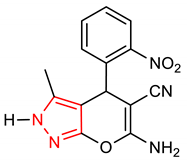 | 6-amino-3-methyl-4-(2-nitrophenyl) -2,4-dihydropyrano[2,3-c]pyrazole-5-carbonitrile |
0.3–30 µM | HO-1, NQO1 | AD, Oxidative stress | AREc32 Cells | Antioxidant, Anti-inflammatory | [23] | [51] | ||||
| 5 | 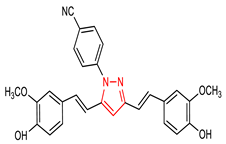 | 4-(3,5-bis((E)-4-hydroxy-3-methoxystyryl)-1H-pyrazol-1-yl)benzonitrile |
1.25–5µM | GPx | Oxidative stress | PC12 Cells | Antioxidant | [24] | [52] | ||||
| 6 | Imidazole core | 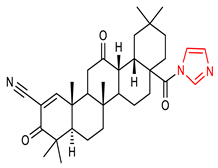 | (4aR,6aS,12aS,12bS,14bR)-8a-(1H-imidazole-1-carbonyl)-4,4,6a,11,11,14b-hexamethyl-3,13-dioxo-3,4,4a,5,6,6a,6b,7,8,8a,9,10,11,12,12a,12b,13,14,14a,14b-icosahydropicene-2-carbonitrile |
50–200 mg/kg | HO-1, NQO1 | Lung cancer | Mice, RAW 264.7 Cells | Antioxidant, Anti-inflammatory | [25] | [59] | |||
| 30 µmol/kg | HO-1, NQO1, GCLC | Acute Kidney Injury | Mice | Antioxidant, Anti-inflammatory | [54] | [60] | |||||||
| 2 mg/kg | HO-1, NQO1, GCLC | Intestinal ischemia/reperfusion | Mice | Antioxidant, Anti-inflammatory | [55] | [61] | |||||||
| 7 | 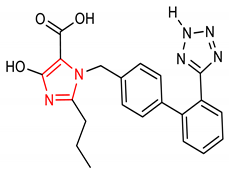 | 1-((2’-(2H-tetrazol-5-yl)-[1,1’-biphenyl]-4-yl)methyl)-4-hydroxy-2-propyl-1H-imidazole-5-carboxylic acid |
10 mg/kg | GPx | Chronic nephrotoxicity | Rats | Antioxidant, Anti-inflammatory | [56] | [64] | ||||
| 8 | Triazole core |  | 4-(3-nitrophenyl)-1-(m-tolyl)-1H-1,2,3-triazole |
10 µM | HO-1, NQO1 | Oxidative stress | HEK293 Cells, FP and NQO1 Assay | Antioxidant | [29] | [70] | |||
| 9 |  | 1-(3-iodophenyl)-4-(3-nitrophenyl)-1H-1,2,3-triazole |
10 µM | HO-1, NQO1 | Oxidative stress | HEK293 Cells, FP and NQO1 Assay | Antioxidant | [29] | [70] | ||||
| 10 |  | 2-(1-(3,5-dimethylphenyl)-5-(2-hydroxyphenyl)-1H-1,2,4-triazol-3-yl)-5-(trifluoromethyl)phenol |
<400 mg/kg | HO-1, NQO1 | Ischemia stroke | Rats | Antioxidants | [31] | [72] | ||||
| 11 | 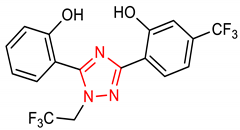 | 2-(5-(2-hydroxyphenyl)-1-(2,2,2-trifluoroethyl)-1H-1,2,4-triazol-3-yl)-5-(trifluoromethyl)phenol |
<1000 mg/kg | HO-1, NQO1 | Cerebral ischemic injury | Rats | Antioxidants | [30] | [71] | ||||
| 12 |  | 4-(3-(2-hydroxy-4-methoxyphenyl)-5-(2-hydroxyphenyl)-1H-1,2,4-triazol-1-yl)benzenesulfonamide |
2.5–10 µM | GPx, SOD | Ischemic stroke | PC12 Cells | Antioxidant | [32] | [73] | ||||
| 13 | Piperidine core | 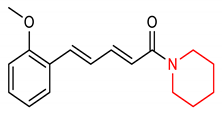 | (2E,4E)-5-(2-methoxyphenyl)-1-(piperidin-1-yl)penta-2,4-dien-1-one |
100 mg/kg | HO-1, NQO1 | PD | PC12 Cells | Antioxiodant | [34] | [76] | |||
| 14 | 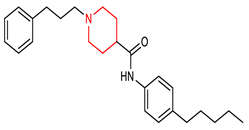 | N-(4-pentylphenyl)-1-(3-phenylpropyl)piperidine-4-carboxamide |
E1/E2/E2 enzymes | Gastric cancer | MIGC803 Cells | Anticancer | [35] | [80] | |||||
| 15 | Pyridine core | 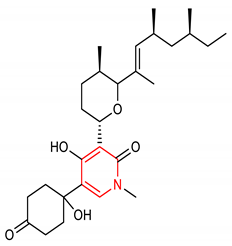 | (+)-4,6-Anhydrooxysporidinone |
2.5 and 5 µM | HO-1 | Oxidative stress, apoptosis | HT22 cells | Antioxidant | [38] | [87] | |||
| 16 | 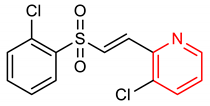 | (E)-3-chloro-2-(2-((2-chlorophenyl)sulfonyl)vinyl)pyridine |
30 mg/kg | HO-1, GCLC, GCLM, SOD-1 | PD | Mice | Antioxidant, anti-inflammatory | [39] | [88] | ||||
| 17 | Pyrimidine core | 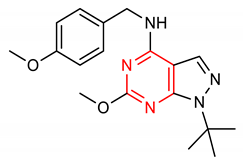 | 1-(tert-butyl)-6-methoxy-N-(4-methoxybenzyl)-1H-pyrazolo[3,4-d]pyrimidin-4-amine |
30 mg/kg | HO-1, NQO1, GCLM, | PD | Mice | Antioxidant, anti-inflammatory | [40] | [94] | |||
| 18 | 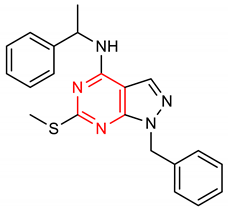 | 1-benzyl-6-(methylthio)-N-(1-phenylethyl)-1H-pyrazolo[3,4-d]pyrimidin-4-amine |
2000 mg/kg | HO-1, NQO1, GCLM, GCLC |
PD | Mice | Antioxidant, anti-inflammatory | [41] | [95] | ||||
| 19 |  | 1-((3-(4-amino-3-methyl-1H-pyrazolo[3,4-d]pyrimidin-1-yl)phenyl)ethynyl)cyclohexanol |
20 µM | HO-1, NQO1 | Ischemia reperfusion injury | Mice | Antioxidant, anti-inflammatory | [42] | [96] | ||||
| 20 | Pyrazine core |  | tetramethyl pyrazine |
20 mg/kg | GCLC | PD | Mice | Antioxidant | [43] | [97] | |||
| 21 | Triazine core | 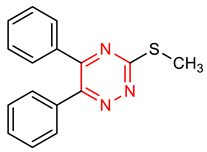 | 3-(methylthio)-5,6-diphenyl-1,2,4-triazine |
10 µM | HO-1, GPx1 | AD | PC12 Cells | Antioxidant | [46] | [103] | |||
| 22 | 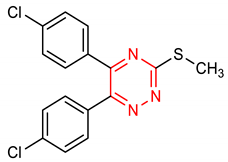 | 5,6-bis(4-chlorophenyl)-3-(methylthio)-1,2,4-triazine |
10 µM | HO-1, GPx1 | AD | PC12 Cells | Antioxidant | [46] | [103] | ||||
| 23 |  | 5,6-bis(4-methoxyphenyl)-3-(methylthio)-1,2,4-triazine |
5–20 µ | HO-1, GPx1 | AD | PC12 Cells | Antioxidant, anti-inflammatory | [47] | [104] |
2.3. Fused/Condensed Nitrogen Heterocyclic Compounds
2.3.1. Indoles
The synthesis of indoles has been reviewed by [57][113]. Indole-3-carbinol (I3C) (24) (Table 2), abundantly found in crucifers, regulates the NRF2 signaling pathway and exerts chemopreventive effects. The compound 24 induces ARE-luciferase activity and NRF2-mediated genes, and suppresses the incidence of palpable tumors and genitourinary weight [58][114]. Although compound 24 is effective in activating the NRF2 signaling pathway, available data indicate that its dimerization to 3,3-iindolylmethane (25) (Table 2) results in improved NRF2-inducing activity. In a comparative study of their potential NRF2-inducing activity in murine fibroblasts (NIH3T3), compound 252.3.2. Quinazolines
Quinazoline is an aromatic fused N-heterocyclic compound containing a benzene and pyrimidine ring. They are biologically active, and are components of several pharmaceuticals, including notable drugs [74][123]. The quinazolinone derivative (31) (Table 2) upregulates the expression levels of NRF2, HO-1 and NQO1, with a consequent downregulation of the expression of KEAP1, AhR and CYP1B1 [66][131]. This modulation of the AhR/CYP1B1/NRF2/KEAP1 signaling pathway by compound 31 accounts for its chemotherapeutic potency in the inhibition of liver carcinogenesis. Tryptanthrin, a natural quinazoline derivative (32) (Table 2) obtained from Isatidis radix, has been found to upregulate the expression levels of NRF2 and its target genes. Compound 32 also exhibits hepatoprotective effects against oxidative stress via the activation of the extracellular signal regulated kinase (ERK)/NRF2 signaling pathway in HepG2 cells [67][132].2.3.3. Isoquinolines
Compounds 33 and 34 activate the NRF2/ARE signaling pathway and elevate NQO1 at the cellular level [68][75][140,141]. Diphenyl isoquinoline-I-amine derivative (35) (Table 2) exhibits anti-amnesic activity which has been linked to its ability to activate the NRF2/HO-1 signaling pathway. Through this activation, it attenuates oxidative stress and cholinergic dysfunction in the prefrontal cortex of mice exposed to scopolamine [69][142]. Furthermore, isoquinoline alkaloid (36) (Table 2) upregulates the expression of NRF2 transcription factor and its target genes such as HO-1, GPX, SOD, CAT and NQO1, which help in alleviating monosodium urate crystal-induced inflammation in rats [71][143]. Isoquinoline PRL-295 (37) (Table 2) increases KEAP1 thermostability in cell lysates and causes a disruption of its interaction with NRF2 in single live cells. This leads to the activation of NRF2 and enhanced hepatocellular protection.34. Structure–Activity Relationship of NRF2-Activating Nitrogen Heterocyclic Molecules
The SAR assessment of nitrogen heterocyclic molecules for improved NRF2-inducing activity is represented in Figure 1. The pyrrolidine moiety in compound 1 influences the antioxidant activity. The introduction of the pyrrolidine moiety to caffeic acid improves its antioxidant activity. The replacement of the OH of the COOH of caffeic acid with pyrrolidine increases its ability to attenuate lipid peroxidation and improve antioxidant capacity via the activation of Nrf2-dependent antioxidant enzyme HO-1 pathway and AKT pathway in heart [76][156]. The SAR studies of pyrazole derivatives indicate that the incorporation of the pyrazole core (3) increases their total antioxidant activity [77][157]. Although compound 6 activates the NRF2 signaling pathway and upregulates the expression levels of HO-1 and NQO1, the introduction of 2- and 3-pyridyl moieties to the imidazole produces better drug candidates 40 and 41, respectively [78][151]. For 1,4-diaryl-1,2,3-triazoles (8 and 9), the insertion of a nitro group at the meta position of the 4-phenyl ring and a nitro (42), methyl (43) or halogen group (44) at the meta position of the 1-phenyl ring are the best conformations required for NRF2 cell-based activity [29][70]. For 1,2,4-triazole derivatives 10, 11 and 12, [31][72] reported that the introduction of alkyl groups at the 3-position of the 1,2,4-triazole moiety enhanced the NRF2-mediated neuroprotective effects. Notably, the 3,5-dimethyl substitution (10) confers the best NRF2-inducing activity and neuroprotection. For piperidine derivatives 13 and 14, the introduction of N,N-dibutyl, N,N-dipropyl, N,N-bistrifluoromethyl or p-methyl to their piperidine scaffold enhances their pharmacological efficiency [79][158]. Compound 16 was designed based on SAR analysis, and it exhibits superlative NRF2-inducing activity. Among the drugs approved by the USA FDA, the pyridine moiety remains the second most commonly introduced aromatic N-heterocycle [80][81][159,160]. According to [82][107], the replacement of chlorobenzene with a pyridine ring and OMe with Cl- in vinyl sulfone (45: EC50 = 530 nM) improves its NRF2-inducing activity (46: EC50 = 0.618 µM). Furthermore, the insertion of 3-Cl into the pyridine ring of 46 confers the highest NRF2-inducing activity (16: EC50 = 0.026 µM).